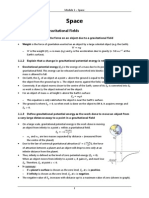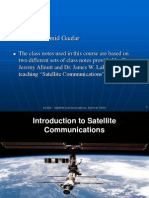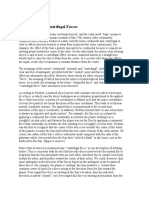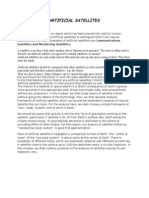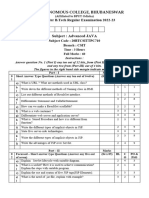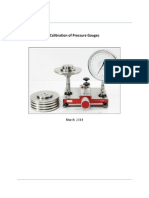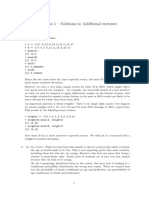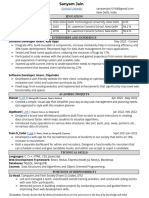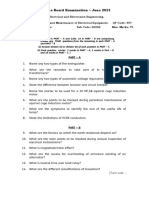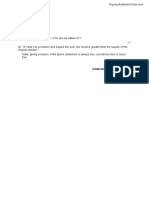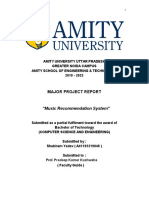Circular Motion Principles For Satellites
Circular Motion Principles For Satellites
Uploaded by
mani420420Copyright:
Available Formats
Circular Motion Principles For Satellites
Circular Motion Principles For Satellites
Uploaded by
mani420420Original Title
Copyright
Available Formats
Share this document
Did you find this document useful?
Is this content inappropriate?
Copyright:
Available Formats
Circular Motion Principles For Satellites
Circular Motion Principles For Satellites
Uploaded by
mani420420Copyright:
Available Formats
Planetary and Satellite Motion
Circular Motion Principles for Satellites
A satellite is any object that is orbiting the earth, sun or other massive body. Satellites can be categorized as natural satellites or man-made satellites. The moon, the planets and comets are examples of natural satellites. Accompanying the orbit of natural satellites are a host of satellites launched from earth for purposes of communication, scientific research, weather forecasting, intelligence, etc. Whether a moon, a planet, or some man-made satellite, every satellite's motion is governed by the same physics principles and described by the same mathematical equations. The fundamental principle to be understood concerning satellites is that a satellite is a projectile. That is to say, a satellite is an object upon which the only force is gravity. Once launched into orbit, the only force governing the motion of a satellite is the force of gravity. Newton was the first to theorize that a projectile launched with sufficient speed would actually orbit the earth. Consider a projectile launched horizontally from the top of the legendary Newton's Mountain - at a location high above the influence of air drag. As the projectile moves horizontally in a direction tangent to the earth, the force of gravity would pull it downward. And as mentioned in Lesson 3, if the launch speed was too small, it would eventually fall to earth. The diagram at the right resembles that found in Newton's original writings. Paths A and B illustrate the path of a projectile with insufficient launch speed for orbital motion. But if launched with sufficient speed, the projectile would fall towards the earth at the same rate that the earth curves. This would cause the projectile to stay the same height above the earth and to orbit in a circular path (such as path C). And at even greater launch speeds, a cannonball would once more orbit the earth, but now in an elliptical path (as in path D). At every point along its trajectory, a satellite is falling toward the earth. Yet because the earth curves, it never reaches the earth. So what launch speed does a satellite need in order to orbit the earth? The answer emerges from a basic fact about the curvature of the earth. For every 8000 meters measured along the horizon of the earth, the earth's surface curves downward by approximately 5 meters. So if you were to look out horizontally along the horizon of the Earth for 8000 meters, you would observe that the Earth curves downwards below this straight-line path a distance of 5 meters. For a projectile to orbit the earth, it must travel horizontally a distance of 8000 meters for every 5 meters of vertical fall. It so happens that the vertical distance that a horizontally launched projectile would fall in its first second is approximately 5 meters (0.5*g*t2). For this reason, a projectile launched horizontally with a speed of about 8000 m/s will be capable of orbiting the earth in a circular path. This assumes that it is launched above the surface of the earth and encounters negligible atmospheric drag. As the projectile travels tangentially a distance of 8000 meters in 1 second, it will drop approximately 5 meters towards the earth. Yet, the projectile will remain the same distance above the earth due to the fact that the earth curves at the same rate that the projectile falls. If shot with a speed greater than 8000 m/s, it would orbit the earth in an elliptical path.
Velocity, Acceleration and Force Vectors The motion of an orbiting satellite can be described by the same motion characteristics as any object in circular motion. The velocity of the satellite would be directed tangent to the circle at every point along its path. The acceleration of the satellite would be directed towards the center of the circle - towards the central body that it is orbiting. And this acceleration is caused by a net force that is directed inwards in the same direction as the acceleration.
This centripetal force is supplied by gravity - the force that universally acts at a distance between any two objects that have mass. Were it not for this force, the satellite in motion would continue in motion at the same speed and in the same direction. It would follow its inertial, straight-line path. Like any projectile, gravity alone influences the satellite's trajectory such that it always falls below its straightline, inertial path. This is depicted in the diagram below. Observe that the inward net force pushes (or pulls) the satellite (denoted by blue circle) inwards relative to its straight-line path tangent to the circle. As a result, after the first interval of time, the satellite is positioned at position 1 rather than position 1'. In the next interval of time, the same satellite would travel tangent to the circle in the absence of gravity and be at position 2'; but because of the inward force the satellite has moved to position 2 instead. In the next interval of time, the same satellite has moved inward to position 3 instead of tangentially to position 3'. This same reasoning can be repeated to explain how the inward force causes the satellite to fall towards the earth without actually falling into it.
Elliptical Orbits of Satellites Occasionally satellites will orbit in paths that can be described as ellipses. In such cases, the central body is located at one of the foci of the ellipse. Similar motion characteristics apply for satellites moving in elliptical paths. The velocity of the satellite is directed tangent to the ellipse. The acceleration of the satellite is directed towards the focus of the ellipse. And in accord with Newton's second law of motion, the net force acting upon the satellite is directed in the same direction as the acceleration - towards the focus of the ellipse. Once more, this net force is supplied by the force of gravitational attraction between the central body and the orbiting satellite. In the case of elliptical paths, there is a component of force in
the same direction as (or opposite direction as) the motion of the object. As discussed in Lesson 1, such a component of force can cause the satellite to either speed up or slow down in addition to changing directions. So unlike uniform circular motion, the elliptical motion of satellites is not characterized by a constant speed.
In summary, satellites are projectiles that orbit around a central massive body instead of falling into it. Being projectiles, they are acted upon by the force of gravity - a universal force that acts over even large distances between any two masses. The motion of satellites, like any projectile, is governed by Newton's laws of motion. For this reason, the mathematics of these satellites emerges from an application of Newton's universal law of gravitation to the mathematics of circular motion.
You might also like
- Force of Foot On Floor (Pushing Backward) Force of Floor On Foot (Reactive Force On Foot's Push)Document4 pagesForce of Foot On Floor (Pushing Backward) Force of Floor On Foot (Reactive Force On Foot's Push)Vann Andrei PagulayanNo ratings yet
- Unit 1-Satellite CommunicationDocument100 pagesUnit 1-Satellite CommunicationvenugopalNo ratings yet
- Winchester Model 1885 2Document13 pagesWinchester Model 1885 2carlosfanjul1No ratings yet
- 2.satellite and Cosmic Speeds SÍDocument2 pages2.satellite and Cosmic Speeds SÍAntonia VelezNo ratings yet
- Researchassessment2 1Document8 pagesResearchassessment2 1api-303093249No ratings yet
- What Are The Forces Acting On A Satellite in OrbitDocument8 pagesWhat Are The Forces Acting On A Satellite in Orbitmahamd saiedNo ratings yet
- Satellite Research: Law of InertiaDocument3 pagesSatellite Research: Law of InertiaibriyhNo ratings yet
- OrbitsDocument2 pagesOrbitsPantsik GrifoiNo ratings yet
- Space Earth's Gravitational FieldDocument8 pagesSpace Earth's Gravitational FieldYaron SaksNo ratings yet
- Universal Gravitation LawDocument11 pagesUniversal Gravitation Lawanurag3069No ratings yet
- GravityDocument2 pagesGravityОленка КушнірNo ratings yet
- Orbital MechanicsDocument2 pagesOrbital MechanicsdiogoNo ratings yet
- Neha KumariDocument13 pagesNeha Kumariatharva sawantNo ratings yet
- 01 Applied Physics N.gasimovDocument12 pages01 Applied Physics N.gasimovRajab RajabovNo ratings yet
- Gravitational SlingshotDocument3 pagesGravitational SlingshotFalihah BalqisNo ratings yet
- Universal Gravitation Satellites and RelativityDocument40 pagesUniversal Gravitation Satellites and Relativityapi-298420434No ratings yet
- Kepler's Law and Earth SatelitesDocument29 pagesKepler's Law and Earth SatelitesMirahmad FadzlyNo ratings yet
- Class 9 Phy Structure of The Solar SystemDocument6 pagesClass 9 Phy Structure of The Solar SystemAbdul NoorNo ratings yet
- phntDocument8 pagesphntlalchhanhimahrahsel44No ratings yet
- Orbits and TidesDocument19 pagesOrbits and TidesdodakomataNo ratings yet
- Reviewer For General Physics 1Document11 pagesReviewer For General Physics 1Yoon JeonghanNo ratings yet
- Relative Motion of Orbiting BodiesDocument10 pagesRelative Motion of Orbiting BodiesNishant BatraNo ratings yet
- Satellite Motion NotesDocument23 pagesSatellite Motion NotesVarshLok100% (1)
- Chapter 4. Interplanetary Trajectories: ObjectivesDocument4 pagesChapter 4. Interplanetary Trajectories: ObjectivesSudharshan SrinathNo ratings yet
- Gravity Is More Than A NameDocument45 pagesGravity Is More Than A Namepk2varmaNo ratings yet
- Sherman Module 1 SpaceDocument20 pagesSherman Module 1 SpaceYousef YohannaNo ratings yet
- Phyiscs PaperDocument5 pagesPhyiscs Paperapi-295339167No ratings yet
- Buldy SatcommDocument16 pagesBuldy SatcommSumit KumarNo ratings yet
- The Equivalence Principle: The General Theory of Relativity Predicts Black HolesDocument9 pagesThe Equivalence Principle: The General Theory of Relativity Predicts Black HolesAlejandro Londoño CardonaNo ratings yet
- Satellite Communications Course Lecture 1 For AASTMTDocument48 pagesSatellite Communications Course Lecture 1 For AASTMTAmr MohamedNo ratings yet
- Gravitation Notes Class10Document8 pagesGravitation Notes Class10Your FriendNo ratings yet
- Project in ScienceDocument9 pagesProject in SciencePaul Michael FermaNo ratings yet
- Space and WeightlessnessDocument15 pagesSpace and WeightlessnessChi Koy100% (2)
- Introduction To Astronautics: Sissejuhatus KosmonautikasseDocument33 pagesIntroduction To Astronautics: Sissejuhatus Kosmonautikassegirithik14No ratings yet
- Universal GravitationalDocument17 pagesUniversal GravitationalaftabNo ratings yet
- CH 12 SolDocument20 pagesCH 12 Solaoeu1234No ratings yet
- Orbital Mechanics-Part IDocument41 pagesOrbital Mechanics-Part IChintu Dabang ChintuNo ratings yet
- Kepler's Laws: 1.2.1 Kepler's Law IntroductionDocument6 pagesKepler's Laws: 1.2.1 Kepler's Law IntroductionsubbuNo ratings yet
- Physics 170 - Mechanics: Gravitational EnergyDocument18 pagesPhysics 170 - Mechanics: Gravitational EnergyAbdulHafizK.No ratings yet
- Gravitation PDFDocument15 pagesGravitation PDFMothi KarunaNo ratings yet
- Centripetal and Centrifugal Forces: Drive Away. Hence The European Scientists of The 17th Century (Who CustomarilyDocument10 pagesCentripetal and Centrifugal Forces: Drive Away. Hence The European Scientists of The 17th Century (Who CustomarilyerkarnanNo ratings yet
- Part Two Math QuestionDocument2 pagesPart Two Math QuestioncharlesglennhensleyNo ratings yet
- Chapter - 8 Physics Notes Class-Xi Gravitation: Newton's Law of GravitationDocument6 pagesChapter - 8 Physics Notes Class-Xi Gravitation: Newton's Law of Gravitationsakshi mishra100% (1)
- Celestial MechanicsDocument8 pagesCelestial MechanicsRuvy Caroro Legara DenilaNo ratings yet
- Orbits and Kepler's Laws: Gravitational ForceDocument6 pagesOrbits and Kepler's Laws: Gravitational ForceDavid Gonzalez ArjonaNo ratings yet
- MODULE 5 Newtons Universal Law of GravitationDocument15 pagesMODULE 5 Newtons Universal Law of Gravitationaklanracing.arpaNo ratings yet
- Newton's Law of Universal Gravitation (Physics)Document43 pagesNewton's Law of Universal Gravitation (Physics)Maryanne100% (2)
- 4.1 Law of GravitationDocument29 pages4.1 Law of GravitationJadidah SaripadaNo ratings yet
- Topic 7 GravitationDocument43 pagesTopic 7 GravitationfrazatasNo ratings yet
- Episode 403 - Orbital Motion - 0Document16 pagesEpisode 403 - Orbital Motion - 0toancoi8837No ratings yet
- History: Rules of ThumbDocument2 pagesHistory: Rules of ThumbDarry BlanciaNo ratings yet
- EPQ DissertationDocument3 pagesEPQ DissertationOliver JonesNo ratings yet
- Handouts For General Physics I Rotational Motion (Activity 1)Document8 pagesHandouts For General Physics I Rotational Motion (Activity 1)snowetntheoriesNo ratings yet
- Project FinalDocument25 pagesProject Finalayan.sachin141No ratings yet
- Artificial SatellitesDocument2 pagesArtificial SatellitesMohammad Riza M. MacknoNo ratings yet
- Midterm Exam in Modern PhysicsDocument3 pagesMidterm Exam in Modern PhysicsRaiza Ann OportoNo ratings yet
- Introduction To Satellite Communication:: Unit I Satellite OrbitsDocument22 pagesIntroduction To Satellite Communication:: Unit I Satellite OrbitsjagadishNo ratings yet
- The Electrogravitic Theory of Celestial Motion and CosmologyFrom EverandThe Electrogravitic Theory of Celestial Motion and CosmologyNo ratings yet
- True Gravity and the Blueprint of the Universe: The Proof of Gravity's CauseFrom EverandTrue Gravity and the Blueprint of the Universe: The Proof of Gravity's CauseNo ratings yet
- Ejercicios Del Tema 1 y Tema 2 - Estatica Beer Jhonson 9edDocument11 pagesEjercicios Del Tema 1 y Tema 2 - Estatica Beer Jhonson 9edJean Pierre MoralesNo ratings yet
- Critical PathDocument6 pagesCritical Pathkitderoger_391648570No ratings yet
- Calculus Session 1 Area of A Region in A PlaneDocument4 pagesCalculus Session 1 Area of A Region in A PlaneJennie Gail RigorNo ratings yet
- 7th CSIT Adv JAVADocument2 pages7th CSIT Adv JAVARakesh Kumar SenNo ratings yet
- Dead Wieght TesterDocument7 pagesDead Wieght TesterMohamed GhoneimNo ratings yet
- Software Engineering LabDocument20 pagesSoftware Engineering LabAyush VaishNo ratings yet
- ST102 Class 1 Additional Exercises SolutionsDocument2 pagesST102 Class 1 Additional Exercises SolutionsJiang HNo ratings yet
- A 456A 456M - 99 (Reapproved 2003) Standard Specification For Magnetic Particle Examination of Large Crankshaft Forgings1Document4 pagesA 456A 456M - 99 (Reapproved 2003) Standard Specification For Magnetic Particle Examination of Large Crankshaft Forgings1Heri VillaNo ratings yet
- Differentiation of Organic From InorganicDocument4 pagesDifferentiation of Organic From InorganicSHARENDRA INJALNo ratings yet
- L18 HornsDocument28 pagesL18 HornsRobert GrubeNo ratings yet
- Performance TaskDocument3 pagesPerformance TasksaisumichoiNo ratings yet
- SanyamJain 29augustDocument1 pageSanyamJain 29augustSanyam JainNo ratings yet
- ESQUEMA ELETRICO 307 E Cat - Dcs.sis - ControllerDocument13 pagesESQUEMA ELETRICO 307 E Cat - Dcs.sis - Controllerrodinei cesar gomes gomesNo ratings yet
- Diploma Board Examination - June 2021Document2 pagesDiploma Board Examination - June 2021Mohan100% (1)
- ProofDocument23 pagesProofZhaorui ZhuNo ratings yet
- Swing Arm Calculation and Analysis JournalDocument5 pagesSwing Arm Calculation and Analysis JournalBálají Sèlvakümár100% (1)
- HP Catalog 1992Document732 pagesHP Catalog 1992moocomNo ratings yet
- Vapor Recovery From Condensate Storage Tanks Using Gas Ejector TechnologyDocument5 pagesVapor Recovery From Condensate Storage Tanks Using Gas Ejector TechnologyPranpath NarupantawartNo ratings yet
- Hydrogen Chloride: Covalent Bonding in HCLDocument34 pagesHydrogen Chloride: Covalent Bonding in HCLSanchita SarkarNo ratings yet
- 1520 0477 Bams D 22 0164.1Document22 pages1520 0477 Bams D 22 0164.1Slobodna DalmacijaNo ratings yet
- Landscape Design: RAR 904 Assignment 01Document6 pagesLandscape Design: RAR 904 Assignment 01Priyangi DixitNo ratings yet
- 4.2.4 - Ohms Law WorksheetDocument1 page4.2.4 - Ohms Law Worksheettomas garciaNo ratings yet
- Report Major Project by ShubhamDocument45 pagesReport Major Project by ShubhamYash KakranNo ratings yet
- YAMAHA RX-V420 SchematicDocument5 pagesYAMAHA RX-V420 SchematicLuiz MarchandNo ratings yet
- Cmo Serie AbDocument20 pagesCmo Serie AbrafinhaleocadioNo ratings yet
- Hydra Big TutorialDocument49 pagesHydra Big TutorialMicke OlofssonNo ratings yet
- Do Immunisations Reduce The Risk For SIDS? A Meta-AnalysisDocument5 pagesDo Immunisations Reduce The Risk For SIDS? A Meta-AnalysisRoss StalkerNo ratings yet
- Perl GTK Reference PDFDocument108 pagesPerl GTK Reference PDFtelesnake45No ratings yet
- Perancangan Dan Implementasi Active Directory Pada Jaringan Komputer Berbasis Windows Server 2003Document12 pagesPerancangan Dan Implementasi Active Directory Pada Jaringan Komputer Berbasis Windows Server 2003mochamad ichsan abdilahNo ratings yet


























